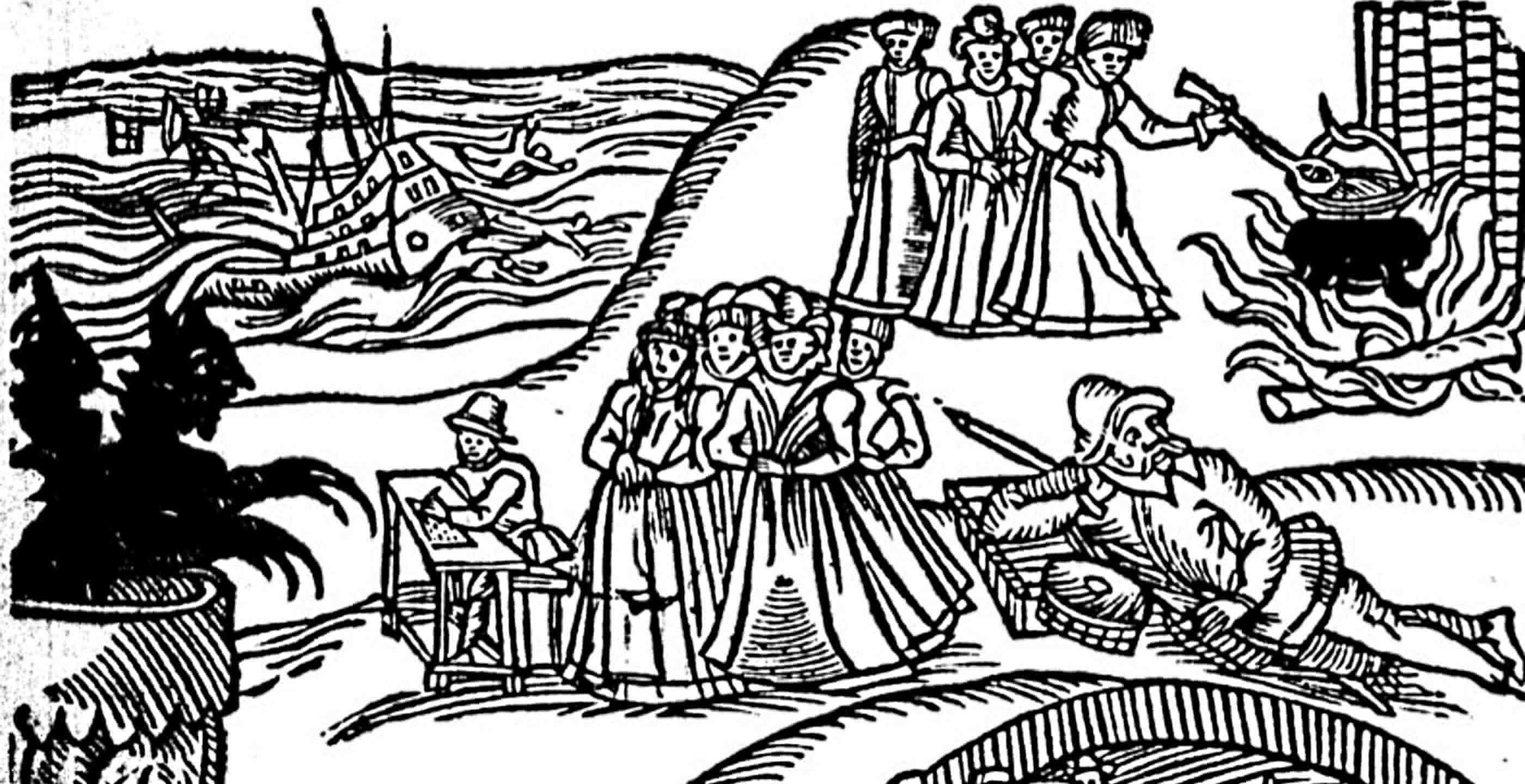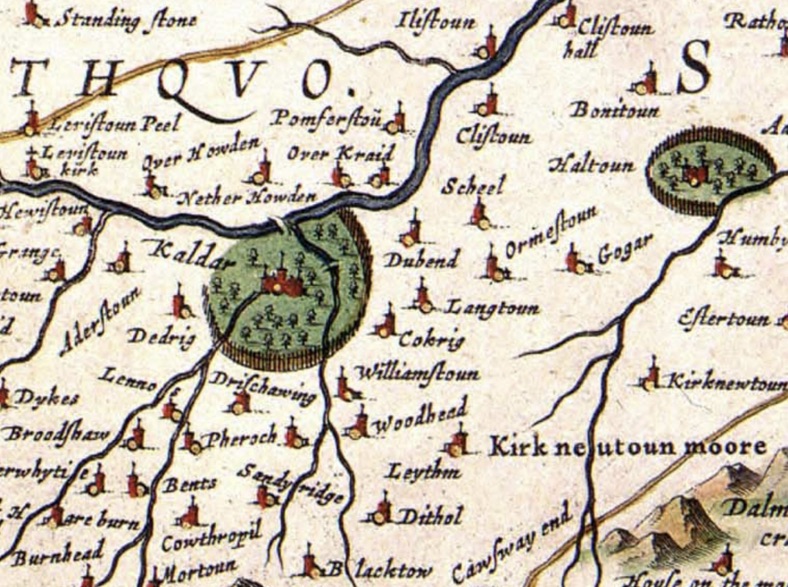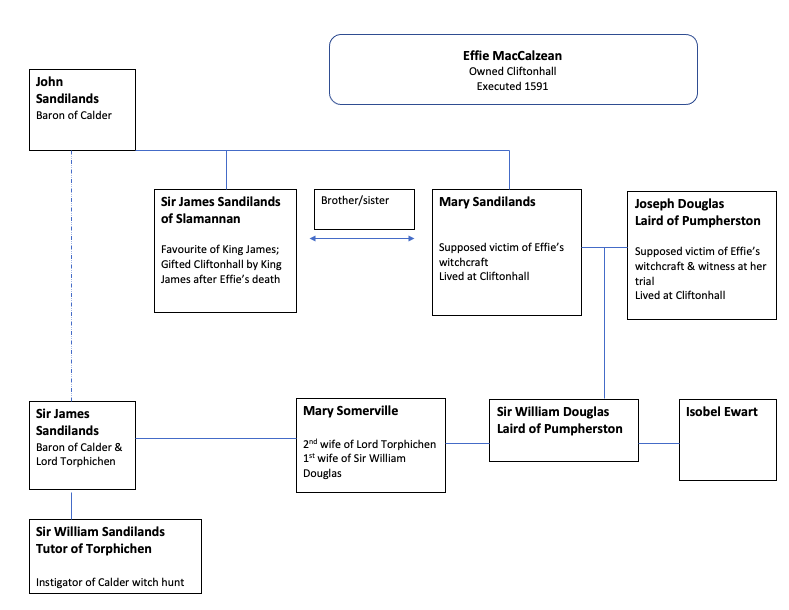Isobel Ewart’s intervention in the Calder witch hunt case is unusual. Not just because we hear the voice of a woman speaking up so clearly for those accused but also because of the recent history of the family she had married into – the Douglas’ of Pumpherston. Isobel’s father-in-law Joseph Pumpherston had been significantly involved in one of Scotland’s most famous witch hunts, that of the North Berwick witches in 1591.
Background to North Berwick witch hunt
The North Berwick witch hunt was Scotland’s first major witch panic and it centered round a group of women and men from the area around Tranent, Preston Pans and North Berwick. It is one of the country’s most significant and well documented episodes mainly because the people involved were accused of trying to murder both King James VI and his new wife Anne of Denmark.
It was claimed that around 60 people gathered at places around North Berwick on various occasions to meet the devil and their primary aim was to murder James. They had raised a storm firstly to kill the King’s wife as she made her way from Denmark to Scotland to marry him. The Queen and her ships had had to retreat from the ferocious weather to the safety of Norway, and subsequently when James, in youthful eagerness. sails to Norway to get her and accompany her back to Scotland –a further storm is raised by these witches which nearly drowns James and kills many of the gentlemen in his retinue.
James had been quite shaken by his near-death experience and allowed himself to be convinced that his enemies were using the Devil to try and kill him. He involves himself directly in the examinations and trials of the witches. By the end of the hunt between 60 and 200 had been accused, many tortured and a number executed.

The whole sorry episode starts in 1590 when David Seton a baillie of the burgh of Tranent accuses his 16 year old maid servant Geillis Duncan of consorting with the devil. Seton was in financial difficulties and was perhaps looking for an explanation as to the cause of his woes.
Geillis is tortured by Seton and other local worthies in Setons own house using amongst other methods pilliwinks – the dreaded thumbscrews. Before long Geillis had confessed and implicated other people.
The coven was said to contain 8-10 major players. One of the main instigators in this attack on his majesty’s person was named as Agnes Sampson who had previously been a respected healer and midwife from Humbie. She was brought before King James and a council of nobles in Holyrood. At first she denied all the charges. Then she was tortured.
‘By special commandment, her head and body hair was shaved and she was fastened to the wall of her cell by a witch's bridle, an iron instrument with 4 sharp prongs forced into the mouth, so that two prongs pressed against the tongue, and the two others against the cheeks. She was kept without sleep and thrown with a rope around her head. She was examined for witches mark which was found on her privities.’ After these ordeals she confessed to the fifty-three indictments against her.
It is sometime after this point the person who connects this witch hunt to Isobel Ewart and the Calder hunt is named by various of those accused - Euphame MCalzean.
Euphame
Euphame or Effie as she was known, was an heiress who owned the Cliftonhall estate. The only child of a well respected, prominent and more importantly wealthy Edinburgh lawyer Thomas McCalzean.

Euphame had been born out of wedlock but had been legitimized soon after her birth and Thomas McCalzean who had no other children had left everything to her in his will. She had married Patrick Moscrop another Edinburgh lawyer and Patrick had taken the name McCalzean as was often the custom when there was a female only heir and the family name would’ve died out.
Euphame is named by those who are originally accused in the North Berwick hunt and the list of accusations against her at her trial are lengthy. Many to do with her treasonous involvement with attempting to kill the King and her attendance at the witches meetings in and around North Berwick. There are also multiple accusations of maleficum, that is using magic or consulting with someone else to use magic to do harm or kill other people. They paint her a quarrelsome difficult woman who kills or attempts to kill many people round her – her husband, her father in law, her nephew, her niece, her neighbour, various children.
At her trial in Edinburgh she is wealthy and of a high social status she is able to have 5 prolocutors who argue her case but unsurprisingly she is found guilty on 10 charges and she is executed on the 25 June. She claims she is pregnant to try and delay execution but she is burnt alive on Castle Hill. The only person we know to have not been strangled before her burning. The unusual punishment may have been because her sins against god and the king were so extreme but also because she provided the link between the lower class women of North Berwick and the attempt to frame the kings cousin Francis Stewart the Earl Of Bothwell as part of this witches conspiracy. Bothwell was a thorn in James political side and James was always wary that have been fomenting a Catholic rebellion.
Accusations against Euphame
The most serious accusations against Euphame involve the treasonous meetings with other witches to do ill to the King. However there are many other supporting accusations and if we look at the rest of the case against her what starts to stand out is who is doing the accusing. Mucj of the evidence is given by people who have something to gain from her death.
In the very first instance the witch hunt originates with Geillis Duncan and her master David Seton in Tranent. David Seton is Euphame’s brother-in0law. He is married to Katherine Moscrop, her husbands’sister. The Setons hold a grudge against the McCalzeans as their father John Moscrop, another lawyer, had left the bulk of his estate to the already wealthy McCalzeans and not the Setons who were reportedly always in financial difficulties. Euphame is accused of poisoning her father in law John Moscrop.
Another sister-in-law accuses her of killing her 17 year old son. A further accusation is from her uncle Henry McCalzean who had attempted unsuccessfully to get his brothers will overturned and who may have expected to have inherited everything. He says that Euphame caused the death of his six year old daughter Lilias.
The Calder connection
More importantly for the Calder connection many of the accusations are from her neighbour at Cliftonhall - Joseph Douglas Laird of Pumpherston, father to William Douglas and future father-in-law to Isobel Ewart. These are amongst the most colourful accusations.
In short Joseph says that he and Effie had an affair or that she wanted to have an affair with him. That she gave him jewels and gold to win him over and when it ended he refuses to hand these back so she consults a witch to get them. He accuses her of trying to poison him. He accuses her of successfully poisoning two of his children. Of the 28 accusations contained in her dittay at her trial, 8 concern Joseph Douglas. Of the 10 she is convicted of, 2 concern Joseph Douglas.
Of the 10 charges that she is convicted of 3 of them have to do with Joseph Douglas
Douglas even attempts to get himself on the jury that is to try another woman in the witch hunt -Barbara Napier, rich wife of a burgess, friend of Euphame’s and a link between Euphame and Sampson. The lawyers however manage to stop this.
So there seems to be a concerted effort by Joseph Douglas to get Euphame convicted. What was Joseph Douglas looking to gain from it? Had he just fallen out with Euphame and a feud had brewed? Feuds between landowning families were very common at this time. Did he really believe that she had caused these dreadful things to happen with her use of magic?
It perhaps becomes clearer when Euphame is executed and her lands and goods are confiscated by the crown. King James gifts the estate at Cliftonhall to one of his favourites, James Sandilandis of Slammanan, half-brother to James Sandilandis Lord Torphichen. He was one of King James favourites and a gentleman of the bed chamber. He is also the brother of Marie Sandilandis and therefore Joseph Douglas’ brother-in-law.

Joseph and Marie end up living at Cliftonhall and in his will in 1637 Joseph is still at Cliftonhall and his daughter Jean inherits land from him there. Of all the players in this sorry episode the Sandilandis and Douglas families appear to have benefited the most.
James Sandilandis is also as one of the Kings favoured soldier, a sworn enemy of the Earl of Bothwell and we can start to wonder whether or not he uses his brother-in-law Joseph to make multiple accusation against Euphame in order to bring Bothwell closer into the heart of the diabolical conspiracy. Cliftonhall being the payment. Or did he see an opportunity to enrich his sister and her husband and claim Euphame’s lands?
The charges are all starting to take on a whole different conspiracy- conspiracy of not of one with the devil but one between men trying the wrest considerable control and money off a woman. A conspiracy to link her to the Kings political enemies? Whether this was the primary cause of the hunt or whether it was just seen as an opportunistic moment to get Euphame or Bothwell or both will remain unknown.
After Euphame’s execution her husband Patrick Moscrop continues to fight to clear Euphame’s name and in 1592 the King overturns the original verdict. They are granted most of the confiscated lands and goods back at the cost of 5000 merks but Cliftonhall is not returned and stays with James Sandilands.
Isobel Ewart
It is perhaps no wonder when in 1644, Isobel Ewart after hearing of the payment David Aikman makes for his wife Jonet Bruce thought that the kirk and the minister Hew Kennedie were after money. She would’ve been well aware that her father-in-law was in possession of an estate that had been confiscated from a so-called witch. A witch that he had in no small part helped on the way to her death. A witch that had been exonerated a year later and yet they still held her lands.
The lands at Cliftonhall had been passed on at Joseph Douglas’ death to his daughter Jean, Isobel’s sister-in-law and so Isobel and her children did not directly benefit from the confiscation of Euphame’s land. However, Isobel would have been keenly aware that status and money was no barrier to being accused and convicted of witchcraft. It makes her and her husband’s willingness to speak out all the more courageous.
Read part one of this blog to find out more.
Acknowledging this work
The Calder witch hunt is a volunteer-led project, please acknowledge our work if you mention the content of this blog, thank you.





